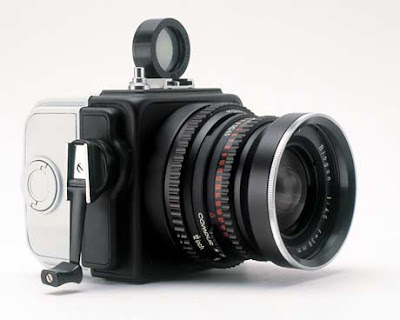Hasselblads in Space:
Tirada com uma Hasselblad EDC.. na Lua..
Hasselblad 500c
The Hasselblad 500C, with a planar 80mm lens (modified), was the first Hasselblad camera to be used by NASA in space. It was purchased by the astronaut Walter M. Schirra from a camera shop in Houston, Texas.
Modification, carried out by NASA, involved removing the lining, mirror, focusing screen and hood, among other things, to make the camera lighter.
Hasselblad SWC
With a Biogon 38mm lens, made its space debut on 3 June 1966, on a voyage in Gemini 9. The camera was largely standard: Only the lining had been removed and the viewfinder was specially designed. The camera was used on four voyages in 1966.
Hasselblad EC (Electric Camera) 500 EL
This camera was taken on the manned voyage which passed close to the moon on 21-27 December 1968. During this voyage 10 revolutions were made around the moon, the purpose being to survey possible future landing sites. The HEC was fitted with a magazine for 70 mm film.

Hasselblad EDC (Electric Data Camera)
This is a specially designed version of the motorized 500EL intended for use on the surface of the moon, where the first lunar pictures were taken on 20 July 1969 by Neil Armstrong. The camera is equipped with a specially designed Biogon lens with a focal length of 60 mm, with a polarization filter mounted on the lens. A glass plate (Reseau-Plate), provided with reference crosses which are recorded on the film during exposure, is in contact with the film, and these crosses can be seen on all the pictures taken on the moon from 1969 to 1972. The 12 HEDC cameras used on the surface of the moon were left there. Only the film magazines were brought back.
Hasselblad 500EL/M
This is the first Hasselblad SLR space camera and it was equipped with a HC3-70 prism viewfinder. It was used for the first time at the Apollo-Soyuz flight in July 1975.
Hasselblad ELS (Space)
The ELS is a modified 553 ELX, with flash metering removed and leatherette replaced with thin metal plates. This camera was used in the early 1990´s on the Space Shuttle missions. The film magazines use 70 mm perforated film and are equipped with electronic data imprinting, enabling the recording of time and picture number for each exposure.
Hasselblad 203S
This space camera is a focal-plane shutter camera based on the standard 203FE version. It is equipped with a special version of the Winder CW. The film magazines use 70 mm perforated film and are equipped with electronic data imprinting, enabling the recording of time and picture number for each exposure. Since the computers onboard have full control over the position of the shuttle it is fairly easy to identify over which spot on the earth the picture was taken.








No comments:
Post a Comment